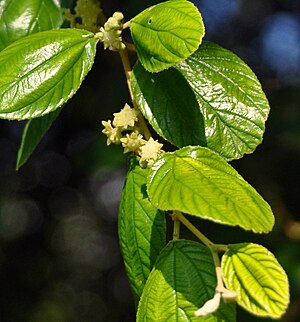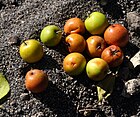Note: This is a project under development. The articles on this wiki are just being initiated and broadly incomplete. You can Help creating new pages.
Difference between revisions of "Ziziphus mauritiana - Common jujube"
(Created page with "{{stub}} Category:Herbs") |
|||
| Line 1: | Line 1: | ||
| − | + | [[File:Zizip maurit 110717-16064 LF sntong.jpg|thumb|right|''Badarah'', ''Ziziphus mauritiana'']] | |
| + | '''Badarah''' is a much branched thorny tree that grows in the drier parts of India. The fruits are enjoyed by animals and man alike. | ||
| + | ==Uses== | ||
| + | {{Uses|Relieves constipation}}, {{Uses|Relieves excessive thirst}}, {{Uses|Improves digestion strength}}, {{Uses|Nasal bleeding}}, {{Uses|Gastric}}, {{Uses|Blood disorders}}, {{Uses|Diarrhea}} | ||
| + | <ref name="Uses"/> | ||
| + | |||
| + | ==Parts Used== | ||
| + | {{Parts Used|Leaves}}, {{Parts Used|Roots}}, {{Parts Used|Fruits}}. | ||
| + | |||
| + | ==Chemical Composition== | ||
| + | |||
| + | |||
| + | ==Common names== | ||
| + | {{Common names|kn=bore, elachi, elanji, yalaci, badari, bare, bari, barihannu|ml=lanta, ilantappalam, lantappalam|sa=Karkandhu, kola, ahapriya, sauveera, gudaphala, baleshta|ta=ilandai, elandai|te=regi, regu-pandu|hi=bara-bor, ber, kath ber,|en=Indian Jujube}} | ||
| + | <ref name="Common names"/> | ||
| + | |||
| + | ==Properties== | ||
| + | Reference: Dravya - Substance, Rasa - Taste, Guna - Qualities, Veerya - Potency, Vipaka - Post-digesion effect, Karma - Pharmacological activity, Prabhava - Therepeutics. | ||
| + | ===Dravya=== | ||
| + | |||
| + | ===Rasa=== | ||
| + | Madhura (Sweet), Amla (Sour) | ||
| + | ===Guna=== | ||
| + | Guru (Heavy), Snigdha (Oily) | ||
| + | ===Veerya=== | ||
| + | Sheeta (Cold) | ||
| + | ===Vipaka=== | ||
| + | |||
| + | ===Karma=== | ||
| + | Kapha, Pitta, Vata | ||
| + | ===Prabhava=== | ||
| + | |||
| + | ==Habit== | ||
| + | {{Habit|Tree}} | ||
| + | |||
| + | ==Identification== | ||
| + | ===Leaf=== | ||
| + | {{Leaf|Simple|Alternate| distichous; stipular spines solitary or in pairs, straight or one of them recurved; nodes slightly enlarged around the leaf scars; petiole 4-8 mm, stout; lamina 1.5-4 x 1.5-3 cm, ovate, elliptic-ovate, elliptic-orbicular or suborbicular, base oblique, subcordate or round, apex round and retuse, margin glandular-denticulate or serrate, glabrous above, coriaceous, strongly 3-ribbed from base, convergent; lateral nerves 2-3 pairs, pinnate, prominent, slender, intercostae obscure. }}<ref name="Leaf"/> | ||
| + | |||
| + | ===Flower=== | ||
| + | {{Flower|Axillary cyme|bisexual|Greenish-yellow|5|n 15-20 flowered dense cymose axillary fascicles; peduncle much reduced; calyx tube 0.5 mm, woolly outside, glabrous within; lobes 5, triangular, prominently keeled on inner face; petals 5, cucullate, round at apex, deflexed with the stamens; disc 10-lobed, grooved; stamens 5, enclosed in the petals, not exserted beyond them; filaments slightly dilated at base; ovary embedded in disc, 2-celled; ovule 1, ascending; styles 2, connate to the middle; stigma 2-fid. }} | ||
| + | |||
| + | ===Fruit=== | ||
| + | {{Fruit|Drupe|1 x 0.5 cm| oblong-globose, yellow or orange when ripe; 1-2-celled|seeds 1 or 2, compressed.|}} | ||
| + | |||
| + | ===Other features=== | ||
| + | |||
| + | ==List of Ayurvedic medicine in which the herb is used== | ||
| + | |||
| + | |||
| + | ==Where to get the saplings== | ||
| + | ==Mode of Propagation== | ||
| + | {{Propagation|Seeds}} | ||
| + | |||
| + | ==How to plant/cultivate== | ||
| + | |||
| + | ===Season to grow=== | ||
| + | |||
| + | ===Soil type=== | ||
| + | |||
| + | |||
| + | ===Propagation=== | ||
| + | |||
| + | ==Commonly seen growing in areas== | ||
| + | {{Commonly seen|Tropical area}}, {{Commonly seen|Dry deciduous forests}}. | ||
| + | |||
| + | ==Photo Gallery== | ||
| + | <gallery class="left" caption="" widths="140px" heights="140px"> | ||
| + | File:Zizip maurit 110716-15922 Fr sntong.jpg | ||
| + | File:Zizip maurit 110717-16070 Fl sntong.jpg | ||
| + | File:Zizip maurit 110716-15914 Fr sntong.jpg | ||
| + | File:Zizip maurit 110901-17127 H bal.jpg | ||
| + | File:Zizip maurit 110717-16059 Fr sntong.jpg | ||
| + | </gallery> | ||
| + | |||
| + | ==References== | ||
| + | |||
| + | <references> | ||
| + | <ref name="Uses">[https://easyayurveda.com/2015/07/26/ber-fruit-indian-jujube-uses-dose-side-effect-research/ "Uses"]</ref> | ||
| + | |||
| + | <ref name="Leaf">[FLOWERING PLANTS OF KERALA VER 2.0, N.SASIDHARAN "BOTANIC DESCRIPTION"]</ref> | ||
| + | |||
| + | <ref name="Common names">[http://envis.frlht.org/bot_search "Vernacular names"]</ref> | ||
| + | </references> | ||
| + | |||
| + | ==External Links== | ||
| + | * [https://www.epainassist.com/articles/health-benefits-of-jujube-fruit-or-ber-or-ziziphus-mauritiana] | ||
| + | * [https://www.researchgate.net/publication/282001594_A_PLANT_REVIEW_ON_ZIZIPHUS_MAURITIANA] | ||
| + | * [http://tropical.theferns.info/viewtropical.php?id=Ziziphus+mauritiana] | ||
[[Category:Herbs]] | [[Category:Herbs]] | ||
| + | [[Category:Tree]] | ||
Revision as of 17:32, 13 April 2019
Badarah is a much branched thorny tree that grows in the drier parts of India. The fruits are enjoyed by animals and man alike.
Contents
- 1 Uses
- 2 Parts Used
- 3 Chemical Composition
- 4 Common names
- 5 Properties
- 6 Habit
- 7 Identification
- 8 List of Ayurvedic medicine in which the herb is used
- 9 Where to get the saplings
- 10 Mode of Propagation
- 11 How to plant/cultivate
- 12 Commonly seen growing in areas
- 13 Photo Gallery
- 14 References
- 15 External Links
Uses
Relieves constipation, Relieves excessive thirst, Improves digestion strength, Nasal bleeding, Gastric, Blood disorders, Diarrhea [1]
Parts Used
Chemical Composition
Common names
| Language | Common name |
|---|---|
| Kannada | bore, elachi, elanji, yalaci, badari, bare, bari, barihannu |
| Hindi | bara-bor, ber, kath ber, |
| Malayalam | lanta, ilantappalam, lantappalam |
| Tamil | ilandai, elandai |
| Telugu | regi, regu-pandu |
| Marathi | NA |
| Gujarathi | NA |
| Punjabi | NA |
| Kashmiri | NA |
| Sanskrit | Karkandhu, kola, ahapriya, sauveera, gudaphala, baleshta |
| English | Indian Jujube |
Properties
Reference: Dravya - Substance, Rasa - Taste, Guna - Qualities, Veerya - Potency, Vipaka - Post-digesion effect, Karma - Pharmacological activity, Prabhava - Therepeutics.
Dravya
Rasa
Madhura (Sweet), Amla (Sour)
Guna
Guru (Heavy), Snigdha (Oily)
Veerya
Sheeta (Cold)
Vipaka
Karma
Kapha, Pitta, Vata
Prabhava
Habit
Identification
Leaf
| Kind | Shape | Feature |
|---|---|---|
| Simple | Alternate | distichous; stipular spines solitary or in pairs, straight or one of them recurved; nodes slightly enlarged around the leaf scars; petiole 4-8 mm, stout; lamina 1.5-4 x 1.5-3 cm, ovate, elliptic-ovate, elliptic-orbicular or suborbicular, base oblique, subcordate or round, apex round and retuse, margin glandular-denticulate or serrate, glabrous above, coriaceous, strongly 3-ribbed from base, convergent; lateral nerves 2-3 pairs, pinnate, prominent, slender, intercostae obscure. |
Flower
| Type | Size | Color and composition | Stamen | More information |
|---|---|---|---|---|
| Axillary cyme | bisexual | Greenish-yellow | 5 | n 15-20 flowered dense cymose axillary fascicles; peduncle much reduced; calyx tube 0.5 mm, woolly outside, glabrous within; lobes 5, triangular, prominently keeled on inner face; petals 5, cucullate, round at apex, deflexed with the stamens; disc 10-lobed, grooved; stamens 5, enclosed in the petals, not exserted beyond them; filaments slightly dilated at base; ovary embedded in disc, 2-celled; ovule 1, ascending; styles 2, connate to the middle; stigma 2-fid. |
Fruit
| Type | Size | Mass | Appearance | Seeds | More information |
|---|---|---|---|---|---|
| Drupe | 1 x 0.5 cm | oblong-globose, yellow or orange when ripe; 1-2-celled | seeds 1 or 2, compressed. | {{{6}}} |
Other features
List of Ayurvedic medicine in which the herb is used
Where to get the saplings
Mode of Propagation
How to plant/cultivate
Season to grow
Soil type
Propagation
Commonly seen growing in areas
Tropical area, Dry deciduous forests.
Photo Gallery
References
- ↑ "Uses"
- ↑ "Vernacular names"
- ↑ [FLOWERING PLANTS OF KERALA VER 2.0, N.SASIDHARAN "BOTANIC DESCRIPTION"]
External Links
Categories:
- Ayurvedic Herbs known to be helpful to treat Relieves constipation
- Ayurvedic Herbs known to be helpful to treat Relieves excessive thirst
- Ayurvedic Herbs known to be helpful to treat Improves digestion strength
- Ayurvedic Herbs known to be helpful to treat Nasal bleeding
- Ayurvedic Herbs known to be helpful to treat Gastric
- Ayurvedic Herbs known to be helpful to treat Blood disorders
- Ayurvedic Herbs known to be helpful to treat Diarrhea
- Herbs with Leaves used in medicine
- Herbs with Roots used in medicine
- Herbs with Fruits used in medicine
- Herbs with common name in Kannada
- Herbs with common name in Hindi
- Herbs with common name in Malayalam
- Herbs with common name in Tamil
- Herbs with common name in Telugu
- Herbs with common name in Sanskrit
- Herbs with common name in English
- Habit - Tree
- Index of Plants which can be propagated by Seeds
- Herbs that are commonly seen in the region of Tropical area
- Herbs that are commonly seen in the region of Dry deciduous forests
- Herbs
- Tree





